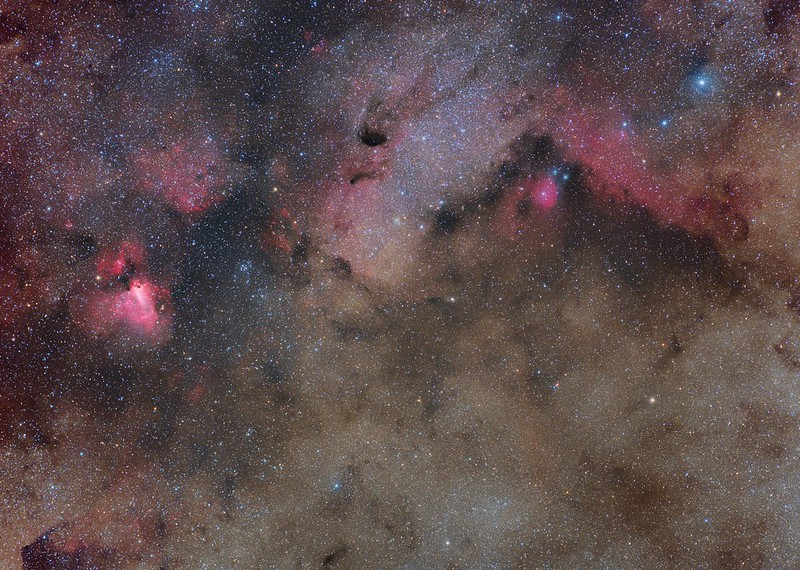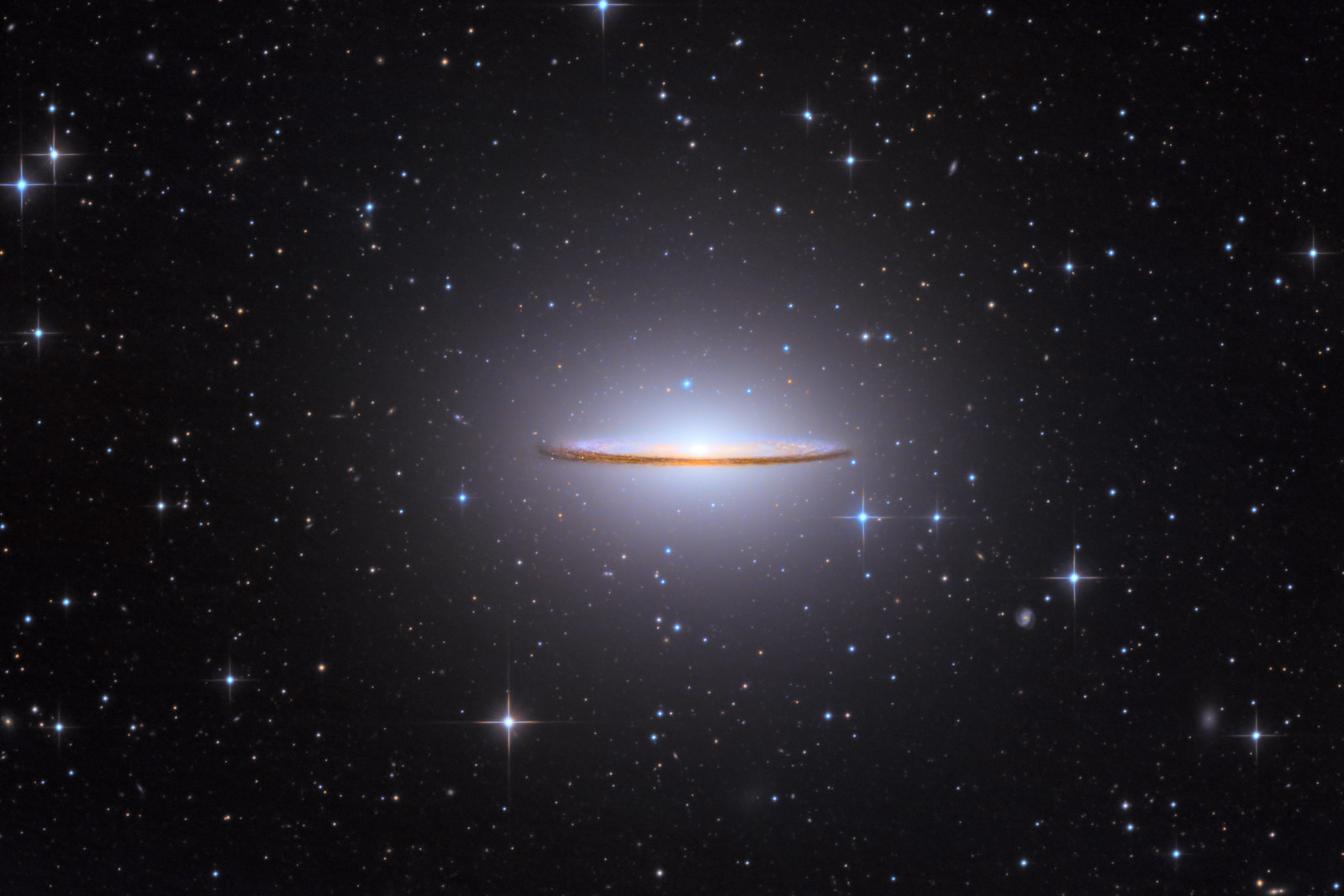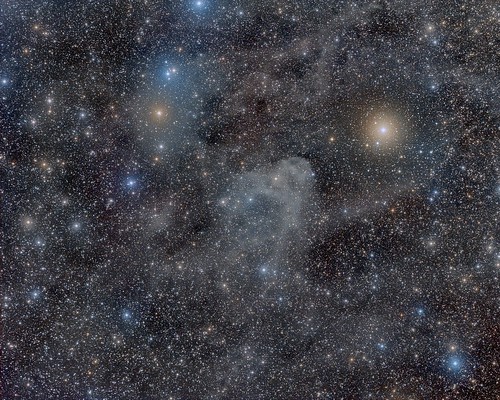Page 1 of 4
Submissions: 2021 August
Posted: Mon Aug 02, 2021 1:54 pm
by bystander
__________________________________________________________________________________________________
Please post your images here.
Please see
this thread before posting images; posting images demonstrates your agreement with
the possible uses for your image.
If hotlinking to an image, please ensure it is under 500K.
Hotlinks to images over 500K slow down the thread too much and will be disabled.
Thank you!
_________________________________________________________________________________________________
<- Previous submissions
Re: Submissions: 2021 August
Posted: Mon Aug 02, 2021 2:40 pm
by thomasroell
In this widefield image of the constellation of Cepheus is a lot to be seen. The familiar targets like the Lobster Claw Nebula and the famous Bubble Nebula, Sharpless 157 and NGC 7635.
But there are also a few surprises to be found, lower right for example is NGC 7538.
And top right is the open cluster Messier 52.
The data was captured during 2 nights a few months ago.
——————————————————————— RGB 55 x 600 iso 6400
Total exposure time 9 hours 10 minutes
🖥 Edited in AstroPixel Processor, Photoshop and Lightroom
.

Sky-watcher HEQ5, TS Optics 115 f/7 Triplet APO, Svbony 60 mm guidescope with a ZWO ASI120MM guidecamera.
🕹ZWO ASIAIR Pro

Canon EOS 6Da, Optolong L-Enhance filter
Re: Submissions: 2021 August
Posted: Mon Aug 02, 2021 3:09 pm
by the_astronomy_enthusiast
Carina Nebula 4 Panel mosiac, processed entirely in pixinsight. Data from Hubble Legacy Archive
 HH 901/902 in the Carina Nebula
HH 901/902 in the Carina Nebula by
William Ostling, on Flickr
Re: Submissions: 2021 August
Posted: Mon Aug 02, 2021 6:59 pm
by Thierry Legault
The ISS? No!!
A few days of vacation with the 8" refractor along the Mediterranean Sea, for this 1/2-second solar transit of the new China's Tiangong Space Station featuring all 3 modules with their solar arrays and certainly the robotic arm.
The 1080p HD video on YT:
https://youtu.be/Bp3jCKvX_tY
Re: Submissions: 2021 August
Posted: Tue Aug 03, 2021 5:47 am
by sydney
NGC 7008 in Cygnus
HaOIII with RGB Stars
Nick Pavelchak
https://www.astrobin.com/users/sydney/
Re: Submissions: 2021 August
Posted: Tue Aug 03, 2021 11:28 am
by Aleix_Roig
Re: Submissions: 2021 August
Posted: Tue Aug 03, 2021 1:10 pm
by mathewbrowne
 Abereiddy Tower and the ISS
Abereiddy Tower and the ISS
by
Mathew Browne, via Flickr /
PhotoHound
The International Space Station shining a path through the twilight above the Pembrokeshire coast. This photo was captured through a window of the Grade II listed Abereiddy Tower (which sits on the headland above the Blue Lagoon), while the setting moon gently illuminated the foreground.
I'm a fastidious planner when it comes to my photos, particularly my astro images - these things don't just happen by accident. You've got to look at the weather, calculate the times and angles of the Space Station's passes to see if they are favourable, and finally you have to find a favourable location to shoot it from.
I'd had this shot in mind for a few years, but it wasn't a location I'd want to tackle alone - it is a challenging scramble to reach with camera gear in tow, but thankfully I had a friend with me as a spotter.
Re: Submissions: 2021 August
Posted: Tue Aug 03, 2021 6:04 pm
by germinianimaicon
Re: Submissions: 2021 August
Posted: Wed Aug 04, 2021 2:02 pm
by the_astronomy_enthusiast
A galactic porpoise - NGC 2936
 A galactic porpoise - NGC 2936
A galactic porpoise - NGC 2936 by
William Ostling, on Flickr
All data was taken by Hubble's Wide Field Camera 3 (WFC3)
The Porpoise Galaxy (NGC 2936) is an irregular galaxy located in the constellation Hydra. It lies at a distance of 352 million light years from the Sun and has an apparent magnitude of 12.85.
Located in the region of the sky between the bright Regulus in Leo and Alphard in Hydra, NGC 2936 is currently in the process of interacting with the elliptical galaxy NGC 2937. As a result of the interaction, the galaxy’s shape has been severely distorted into one that resembles a porpoise or a penguin.
Details!
Data was used from the following proposals:
https://archive.stsci.edu/proposal_sear ... t&id=12812
All processing was done in pixinsight:
R: 814w
G: 606w
B: 475
- denoise
- stretch
- color calibrate
- multiscale processing
Website:
https://theastroenthusiast.com/
Instagram:
http://www.instagram.com/the_astronomy_enthusiast/
Re: Submissions: 2021 August
Posted: Wed Aug 04, 2021 2:43 pm
by barretosmed
MOON
BEST DETAILS
https://www.astrobin.com/full/bosze3/0/
EQUIPMENT:
APO 150MM TRIPLET
ZWO ASI 6200MC
08/03/2021
JALES-SP-BRAZIL
Copyright: Fernando Oliveira de Menezes
Email:
Barretosmed@hotmail.com
Re: Submissions: 2021 August
Posted: Wed Aug 04, 2021 4:40 pm
by mdieterich
Sombrero Galaxy
www.mattdieterich.com
Copyright: Matt Dieterich
The Sombrero Galaxy is home to an estimated 100 billion stars. So many stars are in this galaxy that it literally causes dust surrounding the galaxy to reflect light. Amazing to think this bright galaxy is still 29 million light-years away from Earth. Captured from the dark skies at ObsTech in Chile with a PlaneWave Instruments CDK600 and QHY 600 camera. 2.5 hours Luminance and 30min RGB using 3-min subs. Automation via Voyager.
Re: Submissions: 2021 August
Posted: Thu Aug 05, 2021 10:52 am
by Astro_maa
Re: Submissions: 2021 August
Posted: Thu Aug 05, 2021 4:34 pm
by thomasroell
The little nebula, the Fly, on the left is NGC 1931 and the Large Spider on the right is NGC 417. Both at a distance of about 10.000 light years away in the constellation Auriga. These emission nebula are rich in Hydrogen gas, that’s why they show up so well through an narrowband filter filter.
I have images this part of the sky a little over a year ago too, but this time the nebulae came out much more defined. I’m amazed at the faint spidery filaments which seem to encroach upon the little nebula, it truly deserves its name.
—————————————————————————
RGB 28 x 600 iso 6400
Total exposure time 4 hours and 40 minutes
🖥 Edited in AstroPixel Processor, Photoshop and Lightroom
.

Sky-watcher HEQ5, TS Optics 115 f/7 Triplet APO, Svbony 60 mm guidescope with a ZWO ASI120MM guidecamera.
🕹ZWO ASIAIR Pro

Canon EOS 6Da, Optolong L-Enhance filter
Re: Submissions: 2021 August
Posted: Thu Aug 05, 2021 7:22 pm
by prath83
The Cygnus Wall
Part of a larger emission nebula (NGC7000), The Cygnus Wall is a cosmic ridge that spans about 20 light-years. At a distance of ~1500 light-years, this is one of the most concentrated star formation regions in the sky. Most of the ridge is lit by bright young stars, but also partly hidden by the dark dust created by them. The high contrast due to this phenomenon is what makes this an interesting target to image.
Equipment:
Telescope: Takahashi FSQ106EDXII
Mount: ASA DDM60 Pro
Camera: ZWO ASI1600MM Pro
Filters: Astrodon 5nm Ha, 3nm OIII, 3nm SII
Acquisition:
• 100 X 300s Ha at Gain 200 Offset 50
• 75 X 300s OIII at Gain 200 Offset 50
• 61 X 300s SII at Gain 200 Offset 50

The Cygnus Wall by
Prathamesh Pavaskar, on Flickr
Re: Submissions: 2021 August
Posted: Thu Aug 05, 2021 9:19 pm
by barretosmed
GLOBULAR CLUSTER - MESSIER M22 (NGC 6656)
At the age of 38, in 1665 the German amateur astronomer Johann Abraham Ihle, one night observing Saturn, observed cloud-like spots near Saturn, which was approximately 1° and 40’ away. This was the first globular cluster reported in history.
It is a very bright cluster, located in the constellation of Sagittarius, with an approximate magnitude of 5.1 being the third brightest cluster in the sky, second only to Omega Centauri and 47 Tucanae.
In 1986, the IRAS satellite discovered a feature, quite unusual among clusters, the presence of a planetary nebula, only four known globular clusters contain planetary nebulae, the other three being Messier 15, NGC 6441 and Palomar 6.
Two black holes were discovered in M22 and confirmed by the Chandra X-ray telescope in 2012, designated M22-VLA1 and M22-VLA2, but are believed to have others.
Best details(takes a while to open because the image is gigantic):
https://www.astrobin.com/full/tzqre4/E/
EQUIPMENT:
ZWO ASI 6200MC PRO COLED
Espirit 150mm
55x100s
Date: . 07/10/2021
Location: Jales-SP-Brazil
Copyright: Fernando Oliveira de Menezes
Email:
Barretosmed@hotmail.com
Re: Submissions: 2021 August
Posted: Thu Aug 05, 2021 10:13 pm
by Kinch
LDN 909 & DWB 111
Click on image to enlarge
Full info @
https://www.kinchastro.com/ldn-909--dwb-111.html
Re: Submissions: 2021 August
Posted: Fri Aug 06, 2021 4:32 am
by Leoyasu
Saturn 2021 Opposition, actually almost one day after. The image was taken on Tuesday 08/04 at 04:59am UTC from my backyard in San Miguel, Buenos Aires, Argentina and was the result of stacking and integrating 10 videos of 90 seconds each. The Seeliger effect is pretty impressive both at the eyepiece and in the image, the bands are also nicely seen. The equipment used was a 14" dobson:
Original posts:
(Spanish)
https://www.espacioprofundo.com/topic/3 ... iter-0308/
(English)
https://www.cloudynights.com/topic/7830 ... 14-dobson/
Best regards, Leo.
Re: Submissions: 2021 August
Posted: Fri Aug 06, 2021 6:19 pm
by Iaffaldano Giuseppe Carmine
Re: Submissions: 2021 August
Posted: Fri Aug 06, 2021 6:22 pm
by Iaffaldano Giuseppe Carmine
Re: Submissions: 2021 August
Posted: Sat Aug 07, 2021 10:57 am
by ExplorerEGYWO
My image for Elephant Trunk Nebula "IC 1396". Image was taken at Bortle 8 Sky .
Integration Time :
180 min for Ha
135 min for Oiii
150 min for Sii
The subs were taken on several nights from 28 July to 6 August 2021.
Equipment:
Redcat 51 , ZWO 294 mm pro, Antila Ha&Sii 3nm Filters. Optolong Oiii 6.5 nm.
Skywatcher EQM 35 Mount.
https://www.astrobin.com/tig6p5/0/

Re: Submissions: 2021 August
Posted: Sat Aug 07, 2021 1:53 pm
by olivierr31
The Omega Nebula (M17)
Acquisitions : June 2021
Ha-SHO (6nm narrow band filters)
Bin1x1 Ha:3h18, Bin2x2 OIII:1h30mn & SII:1h51mn exposure time
200/1000 mm Newtonian telescope
Camera ZWO ASI1600MM Pro
Guiding with AOG and ZWO ASI1174MM mini camera using PHD2
Automatic acquisition with APT
Preprocessing with SIRIL
Image processing with Photoshop
Final touch with Lightroom

Details:
https://www.astrobin.com/08xfqu/0
Website :
https://astrophoto.pagesperso-orange.fr
Re: Submissions: 2021 August
Posted: Sun Aug 08, 2021 6:30 am
by Soumyadeep Mukherjee
Re: Submissions: 2021 August
Posted: Sun Aug 08, 2021 7:18 am
by consumedbystarlight

Equipment Details:
Sony A7RII with Sigma 24mm Art Lens and Gobe ND1000 filter for images of the Sun
Post-processing Details:
Photos aligned with calibration images and layered in Photoshop. Panorama stitched with Lightroom and final image tweaks applied in Lightroom.
Image Details:
A year in the Sun
Started this Analemma project August 5, 2020 and the last image for the year cycle was taken on July 28, 2021
The landscape photo with the Neutral Density filter removed and over exposed Sun was taken on December 6, 2020, day of the years earliest sunset, from Libby Hill Park Richmond Virginia as a 4 panel panorama and aligned with the sun images all with camera pointing 245°SW.
This photo contains 49 images spaced out by 5 to 10 days with a filter for the sun exposures, plus the panorama bringing the total to 50 images.
All images were shot from the same exact location at 4 and 5 pm eastern due to daylight savings using an Atomic Clock app.
Re: Submissions: 2021 August
Posted: Mon Aug 09, 2021 12:10 am
by KuriousGeorge
Galaxies in Lacerta. KG Observatory, Julian CA.
It's not often that we think of galaxies in the small constellation of Lacerta because it lies in the Milky Way region between Cygnus and Cassiopeia. There is however a section of the constellation that lies outside the Milky Way’s boundaries and approaches the border of Pegasus and it is here that we find the galaxies.
This galaxy group is known as USGC U813. The group comprises of 8 galaxies including NGC 7265, NGC 7264, UGC 12013 and UGC 12007.
NGC 7265 itself is an E/S0 galaxy with an active core. NED currently leans towards giving NGC 7265 a classification of S0 (lenticular). This type of galaxy is normally only found in galaxy clusters so it must be possible that the NGC 7265 group is or has been associated with a much larger group. The distance to the group is approximately 240 million light years. The whole group appears to be associated with the Perseus super cluster of galaxies.
NGC 7265 itself was discovered by Edouard Stephan in 1876 using a 31” sliver on glass reflector whilst NGC 7264 was found by Marth using Lassell’s 48” speculum metal reflector from Malta in 1863. NGC 7263 does not appear to be part of the same group of galaxies. Steve Gottleib in his NGC notes has observed all of the NGC galaxies in this region but they are described as faint and he was observing from high clear California skies. NGC 7264 looks like a smaller version of the classic edge on NGC 4565 in Coma from the images.
https://www.astrobin.com/ltjxkx/
Re: Submissions: 2021 August
Posted: Mon Aug 09, 2021 1:35 pm
by Astrodude13
3.08 hours of exposure
Location: Rio Hurtado Valley, Chile
ZWO ASI 1600MM Pro
Samyang 135mm lens @ f/3.6
Astrodon Series 2 filters
L:300sec
R:300sec
G:300sec
B:300sec
Processing in Astro Pixel Processor, Adobe Lightroom, and Aurora HDR
 War_and_Peace_Wide
War_and_Peace_Wide by
Blake Estes, on Flickr













